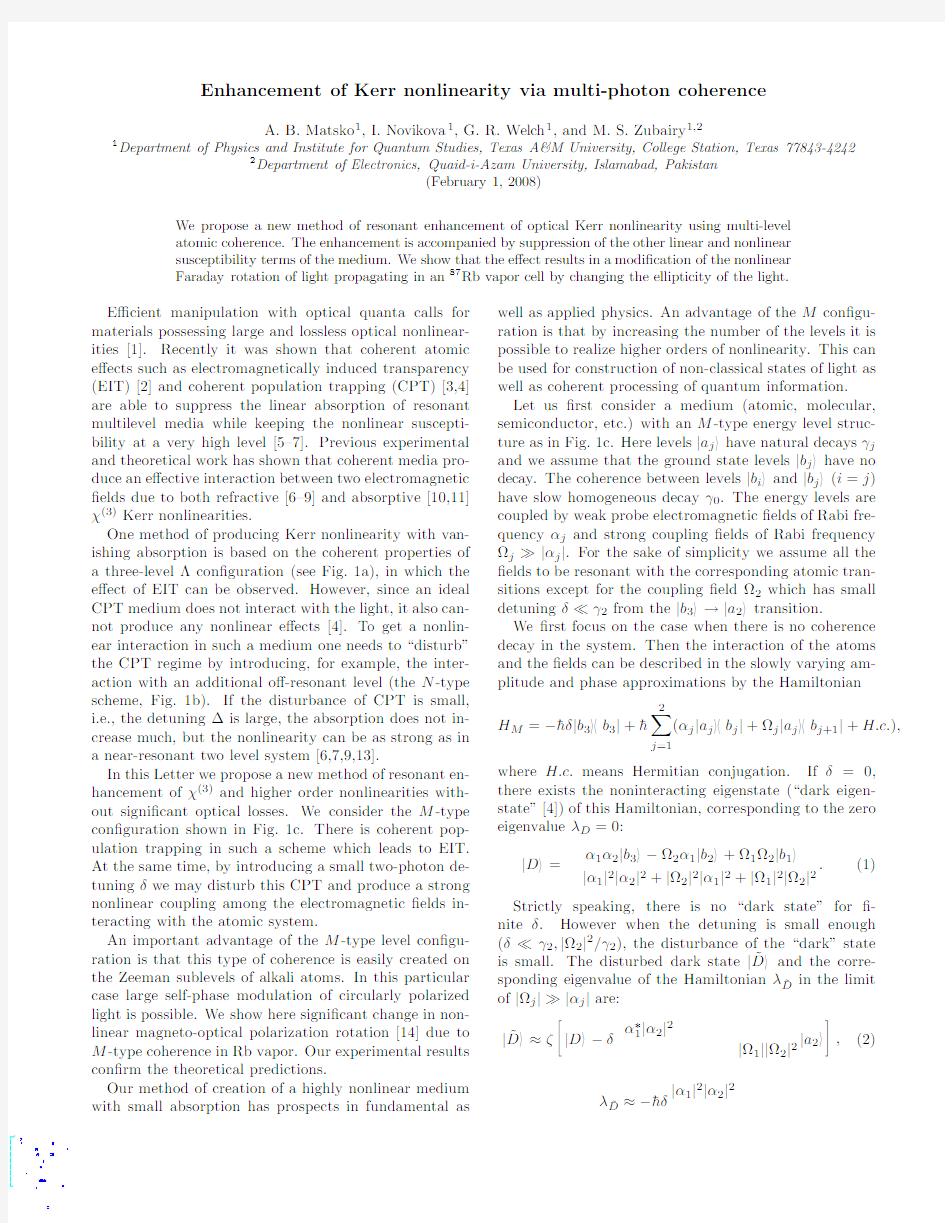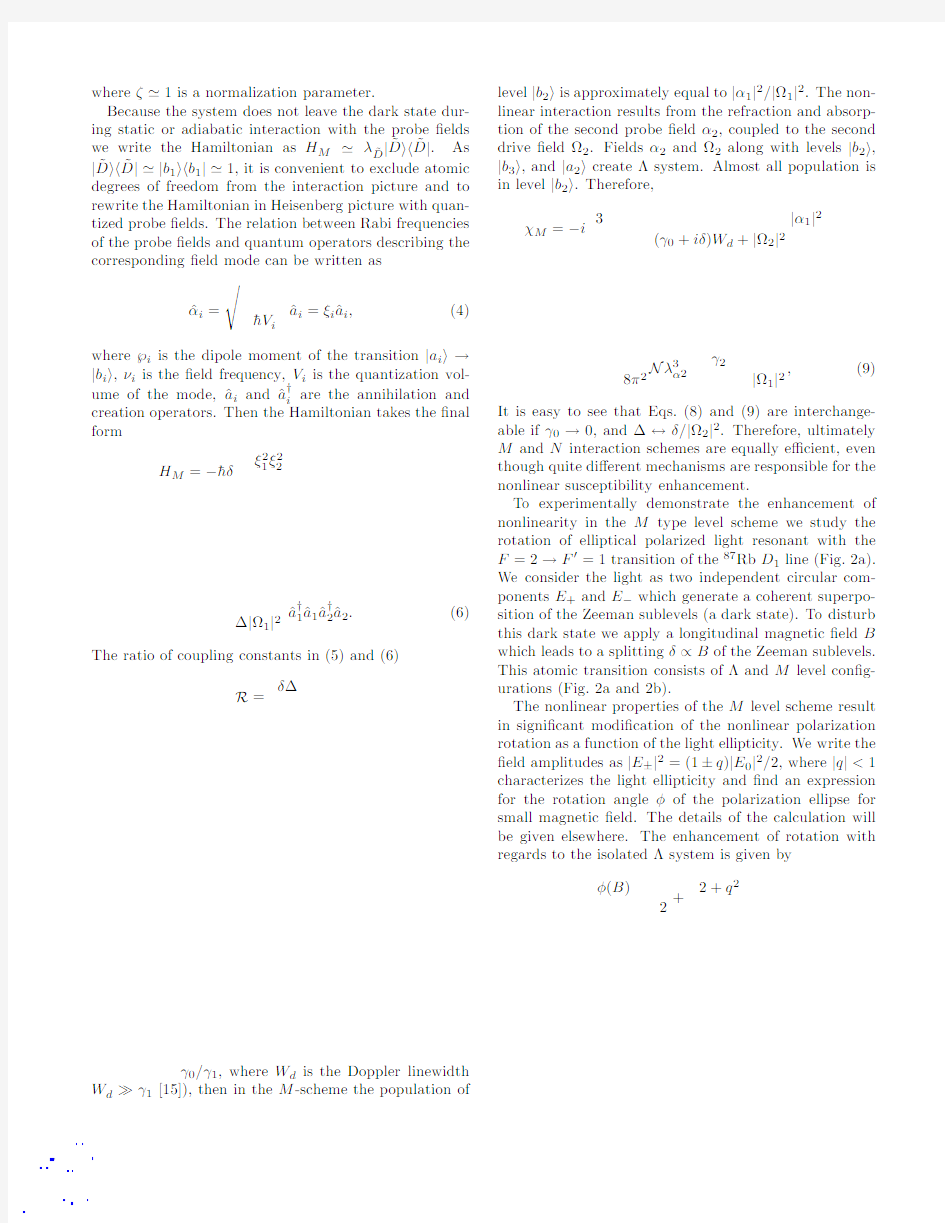Enhancement of Kerr nonlinearity via multi-photon coherence


a r X i v :q u a n t -p h /0207141v 1 24 J u l 2002
Enhancement of Kerr nonlinearity via multi-photon coherence
A.B.Matsko 1,I.Novikova 1,G.R.Welch 1,and M.S.Zubairy 1,2
1
Department of Physics and Institute for Quantum Studies,Texas A&M University,College Station,Texas 77843-4242
2
Department of Electronics,Quaid-i-Azam University,Islamabad,Pakistan
(February 1,2008)
We propose a new method of resonant enhancement of optical Kerr nonlinearity using multi-level atomic coherence.The enhancement is accompanied by suppression of the other linear and nonlinear susceptibility terms of the medium.We show that the e?ect results in a modi?cation of the nonlinear Faraday rotation of light propagating in an 87Rb vapor cell by changing the ellipticity of the light.
E?cient manipulation with optical quanta calls for materials possessing large and lossless optical nonlinear-ities [1].Recently it was shown that coherent atomic e?ects such as electromagnetically induced transparency (EIT)[2]and coherent population trapping (CPT)[3,4]are able to suppress the linear absorption of resonant multilevel media while keeping the nonlinear suscepti-bility at a very high level [5–7].Previous experimental and theoretical work has shown that coherent media pro-duce an e?ective interaction between two electromagnetic ?elds due to both refractive [6–9]and absorptive [10,11]χ(3)Kerr nonlinearities.
One method of producing Kerr nonlinearity with van-ishing absorption is based on the coherent properties of a three-level Λcon?guration (see Fig.1a),in which the e?ect of EIT can be observed.However,since an ideal CPT medium does not interact with the light,it also can-not produce any nonlinear e?ects [4].To get a nonlin-ear interaction in such a medium one needs to “disturb”the CPT regime by introducing,for example,the inter-action with an additional o?-resonant level (the N -type scheme,Fig.1b).If the disturbance of CPT is small,i.e.,the detuning ?is large,the absorption does not in-crease much,but the nonlinearity can be as strong as in a near-resonant two level system [6,7,9,13].
In this Letter we propose a new method of resonant en-hancement of χ(3)and higher order nonlinearities with-out signi?cant optical losses.We consider the M -type con?guration shown in Fig.1c.There is coherent pop-ulation trapping in such a scheme which leads to EIT.At the same time,by introducing a small two-photon de-tuning δwe may disturb this CPT and produce a strong nonlinear coupling among the electromagnetic ?elds in-teracting with the atomic system.
An important advantage of the M -type level con?gu-ration is that this type of coherence is easily created on the Zeeman sublevels of alkali atoms.In this particular case large self-phase modulation of circularly polarized light is possible.We show here signi?cant change in non-linear magneto-optical polarization rotation [14]due to M -type coherence in Rb vapor.Our experimental results con?rm the theoretical predictions.
Our method of creation of a highly nonlinear medium with small absorption has prospects in fundamental as
well as applied physics.An advantage of the M con?gu-ration is that by increasing the number of the levels it is possible to realize higher orders of nonlinearity.This can be used for construction of non-classical states of light as well as coherent processing of quantum information.Let us ?rst consider a medium (atomic,molecular,semiconductor,etc.)with an M -type energy level struc-ture as in Fig.1c.Here levels |a j have natural decays γj and we assume that the ground state levels |b j have no decay.The coherence between levels |b i and |b j (i =j )have slow homogeneous decay γ0.The energy levels are coupled by weak probe electromagnetic ?elds of Rabi fre-quency αj and strong coupling ?elds of Rabi frequency ?j ?|αj |.For the sake of simplicity we assume all the ?elds to be resonant with the corresponding atomic tran-sitions except for the coupling ?eld ?2which has small detuning δ?γ2from the |b 3 →|a 2 transition.
We ?rst focus on the case when there is no coherence decay in the system.Then the interaction of the atoms and the ?elds can be described in the slowly varying am-plitude and phase approximations by the Hamiltonian H M =?ˉh δ|b 3 b 3|+ˉ
h 2 j =1
(αj |a j b j |+?j |a j b j +1|+H.c.),
where H.c.means Hermitian conjugation.If δ=0,there exists the noninteracting eigenstate (“dark eigen-state”[4])of this Hamiltonian,corresponding to the zero eigenvalue λD =0:
|D =
α1α2|b 3 ??2α1|b 2 +?1?2|b 1 |α1|2|α2|2+|?2|2|α1|2+|?1|2|?2|2
.
(1)
Strictly speaking,there is no “dark state”for ?-nite δ.However when the detuning is small enough (δ?γ2,|?2|2/γ2),the disturbance of the “dark”state
is small.The disturbed dark state |?D and the corre-sponding eigenvalue of the Hamiltonian λ?D in the limit of |?j |?|αj |are:
|?D ≈ζ |D ?δα?1|α2|2
|?1||?2|2
|a 2 ,(2)
λ?D ≈?ˉ
h δ|α1|2|α2|2
whereζ?1is a normalization parameter.
Because the system does not leave the dark state dur-ing static or adiabatic interaction with the probe?elds we write the Hamiltonian as H M?λ?
D
|?D ?D|.As |?D ?D|?|b1 b1|?1,it is convenient to exclude atomic degrees of freedom from the interaction picture and to rewrite the Hamiltonian in Heisenberg picture with quan-tized probe?elds.The relation between Rabi frequencies of the probe?elds and quantum operators describing the corresponding?eld mode can be written as
?αi= ˉh V i?a i=ξi?a i,(4)
where?i is the dipole moment of the transition|a i →|b i ,νi is the?eld frequency,V i is the quantization vol-ume of the mode,?a i and?a?i are the annihilation and creation operators.Then the Hamiltonian takes the?nal form
H M=?ˉhδ
ξ21ξ22
?|?1|2
?a?1?a1?a?2?a2.(6) The ratio of coupling constants in(5)and(6)
R=
δ?
γ0/γ1,where W d is the Doppler linewidth W d?γ1[15]),then in the M-scheme the population of level|b2 is approximately equal to|α1|2/|?1|2.The non-linear interaction results from the refraction and absorp-tion of the second probe?eldα2,coupled to the second drive?eld?2.Fieldsα2and?2along with levels|b2 , |b3 ,and|a2 createΛsystem.Almost all population is in level|b2 .Therefore,
χM=?i
3
(γ0+iδ)W d+|?2|2
|α1|2
8π2
Nλ3α2
γ2
|?1|2
,(9)
It is easy to see that Eqs.(8)and(9)are interchange-able ifγ0→0,and??δ/|?2|2.Therefore,ultimately M and N interaction schemes are equally e?cient,even though quite di?erent mechanisms are responsible for the nonlinear susceptibility enhancement.
To experimentally demonstrate the enhancement of nonlinearity in the M type level scheme we study the rotation of elliptical polarized light resonant with the F=2→F′=1transition of the87Rb D1line(Fig.2a). We consider the light as two independent circular com-ponents E+and E?which generate a coherent superpo-sition of the Zeeman sublevels(a dark state).To disturb this dark state we apply a longitudinal magnetic?eld B which leads to a splittingδ∝B of the Zeeman sublevels. This atomic transition consists ofΛand M level con?g-urations(Fig.2a and2b).
The nonlinear properties of the M level scheme result in signi?cant modi?cation of the nonlinear polarization rotation as a function of the light ellipticity.We write the ?eld amplitudes as|E±|2=(1±q)|E0|2/2,where|q|<1 characterizes the light ellipticity and?nd an expression for the rotation angleφof the polarization ellipse for small magnetic?eld.The details of the calculation will be given elsewhere.The enhancement of rotation with regards to the isolatedΛsystem is given by
φ(B)
2
+
2+q2
The experimental results pertain to a semiclassical de-scription where the?eld is classical.An interesting ap-plication of the Kerr nonlinearity with quantized?eld as given in Eq.(5)is the possible implementation of a quan-tum phase gate.A quantum phase gate,together with a one-bit unitary gate,form the basic building block for quantum computation[12].The transformation proper-ties of a quantum phase gate leave the two qubit states unchanged when one or both input qubits are in the logic state0and introduces a phaseηonly when both the qubits in the input states are1.For input photon states |0 or|1 for the two qubits,a unitary operator of the form Qη=exp(iη?a?1?a1?a?2?a2)can lead to such a phase gate,i.e.,Qη|01,02 =|01,02 ,Qη|01,12 =|01,12 , Qη|11,02 =|11,02 ,and Qη|11,12 =exp(iη)|01,02 . It is clear that such a phase gate can be realized via Hamiltonian H M with the time-evolution unitary op-erator exp(?iH M t)and the corresponding phaseη=ˉhδξ21ξ22t/|?1|2|?2|2.
The resonant enhancement ofχ(5)and higher orders of nonlinearity may be achieved using additionalΛsections connected to M scheme,similar to the generalized N scheme[13].Suchχ(5)nonlinearity may be so high that three-photon phase gates become feasible.
In conclusion,we have proposed a realization of media with resonantly enhanced Kerr nonlinearity where one-photon resonant absorption is suppressed due to coher-ence e?ects.Such media have certain advantages over al-ready existing schemes of coherent resonant nonlinearity enhancement and hold promise for the use in the creation of non-classical states of light and in the implementation of quantum computing algorithms.
The authors gratefully acknowledge the support from Air Force Research Laboratory(Rome,NY),DARPA-QuIST,the O?ce of Naval Research,and the TAMU Telecommunication and Informatics Task Force(TITF) initiative.
N o r m a l i z e d r o t a t i o n s l o p e d φ/d B
Ellipticity q
FIG.3.The slope of nonlinear magneto-optic rotation as a function of the ellipticity of the incident light.The slope is normalized by the value for linearly polarized light (zero ellipticity).Experimental data are shown by squares (1mW laser power)and (2mW laser power),while the results of the numerical simulations for the case of 2mW laser power are shown by the solid line.The laser beam has 2mm diameter.Inset:the theoretical dependence for naturally broadened Rb vapor,from Eq.(10).
4
